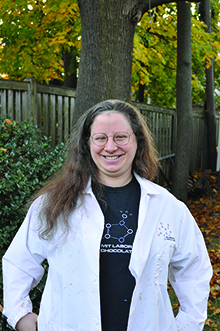Confessions of a Chocoholic
Of all the things I did as an MIT student, the one that’s had the largest impact happened by accident.

It was the spring of 2002. We were still in that halcyon period when everyone had realized that selling stuff online was going to be the next big thing but hadn’t yet figured out how to make a profit. I found an online vendor willing to ship me 50 pounds of chocolate for a price so low that even my college-student budget couldn’t resist. When the package arrived, the desk workers at my dorm argued over who got the privilege of carrying it to my room—no one had seen chocolate in those quantities before.
Then I faced the challenge of what to do with 50 pounds of chocolate.
I’d made enough truffles before to have a basic grasp of the formula, and I had enjoyed going through my grandfather’s liquor collection to see what went well with chocolate. This was a chance to try much crazier things than peach brandy, secure in the knowledge that no matter how much chocolate I wasted, there was always more. My creativity alone wasn’t up to taking full advantage of the opportunity, though. I rounded up as many friends as I could, and we took over the biggest kitchen in Senior Haus. Five gallons of cream and the contents of several spice racks and liquor cabinets later, we had enough truffles to feed three dorms with extras left over.
Our concoctions weren’t all successes. I can’t recommend the “all the red ingredients” recipe (which included merlot, grenadine, and cayenne pepper), and the only consensus on our wasabi-mint truffle was that it had either too much mint or too much wasabi. But many were delicious, including some unexpected favorites. (A package of Jell-O, a bag of white chocolate chips, and a cup of cream heated and stirred until smooth make for astonishingly addictive fruit creams, especially when dipped in dark chocolate. Do try it at home.) During our third truffle party, people I didn’t know started coming up to me and asking if they could play too; a passerby asked if she could join our club.

The next thing I knew, I was sitting with my friend Kat in a lounge, putting together a student activity application. In a play on MIT’s Laboratory for Computer Science, we named our new club the Laboratory for Chocolate Science. When we presented our application to the Association of Student Activities, we brought along leftover truffles, delivering them after our application was approved so no one could accuse us of bribery. (LCS was the first student activity to expand upon the legally required antidiscrimination clause in its club constitution: members are not allowed to discriminate based on a preference for dark, milk, or white chocolate. We saw the “white chocolate isn’t real chocolate” wars coming.)
In less than a year, my impulsive online purchase had become a full-fledged student group, with dozens of active members. We staged brownie-recipe competitions, hosted lectures, taught ourselves how to run chocolate tastings, and eventually handed the club off to a new generation of students.
More than a decade on, I can’t take credit for LCS’s amazing success. We’ve been featured in the New York Times and even Doonesbury, but far more impressive to my mind are the new traditions of IAP truffle classes, chocolate brunches for parents’ weekend, and finals hot cocoa. LCS now orders hundreds of pounds of chocolate per year for the MIT student body and uses it in all kinds of inspiringly creative ways. This past fall, a student proposed a project analyzing the tensile strength of chocolate melted at different temperatures. LCS chocolates are featured at official Institute events, because they’re a delicious way to show just how creative MIT students are.
LCS has taken me places I never expected; I now have my own geeky part-time chocolate business, Dark Matter Chocolate Laboratory. And yet what I value more than anything else is hearing that today, at least among some students, truffle-making is considered one of the quintessential skills to learn at MIT.
LCS founder Ariel Segall ’02 is a security architect at Akamai. After hours she creates chocolate confections like the robotic Daleks from Doctor Who pictured above.
Keep Reading
Most Popular
Large language models can do jaw-dropping things. But nobody knows exactly why.
And that's a problem. Figuring it out is one of the biggest scientific puzzles of our time and a crucial step towards controlling more powerful future models.
The problem with plug-in hybrids? Their drivers.
Plug-in hybrids are often sold as a transition to EVs, but new data from Europe shows we’re still underestimating the emissions they produce.
Google DeepMind’s new generative model makes Super Mario–like games from scratch
Genie learns how to control games by watching hours and hours of video. It could help train next-gen robots too.
How scientists traced a mysterious covid case back to six toilets
When wastewater surveillance turns into a hunt for a single infected individual, the ethics get tricky.
Stay connected
Get the latest updates from
MIT Technology Review
Discover special offers, top stories, upcoming events, and more.